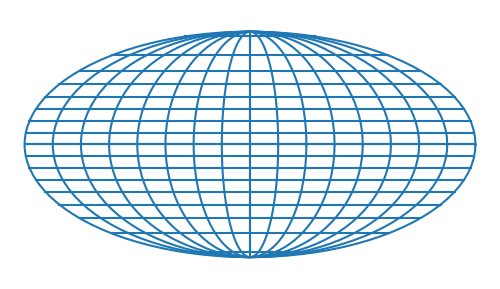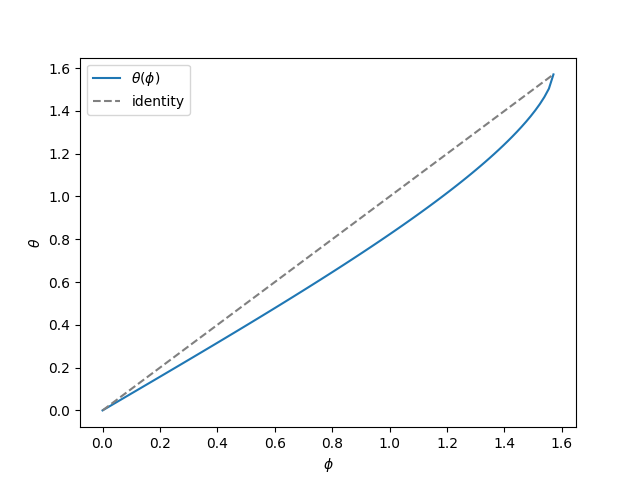Mollweide map projection and Newton’s method

Karl Brandan Mollweide (1774-1825) designed an equal-area map projection, mapping the surface of the earth to an ellipse with an aspect ratio of 2:1. If you were looking at the earth from a distance, the face you're looking at would correspond to a circle in the middle of the Mollweide map [1]. The part of the earth that you can't see is mapped to the rest of the ellipse.
The lines of latitude are not quite evenly spaced; some distortion is required to achieve equal area. Instead, latitude corresponds to on the map according to the equation
There is no closed-form solution for as a function of and so the equation must be solved numerically. For each we have to find the root of
Here's a plot of as a function of .

Newton's method works efficiently (converges quadratically) except when is close to /2. The reason Newton's method slows down for high latitudes is thatf and its derivative are both at /2, i.e. f has a double root there.
Newton's method slows down from quadratic to linear convergence near a double root, but there is a minor modification that maintains quadratic convergence near a double root.
When m = 1 this is the usual form of Newton's method. Setting m = 2 tunes the method for double roots.
The modified version of Newton's method with m = 2 works when the root you're trying to is exactly a double root. However, if you're trying to find a root near a double root, settingm = 2 can cause the method to diverge, so you have to be very careful with changing m.
IllustrationHere's a version of Newton's method, specialized for the Mollweide equation. We can specify the value ofm, and the initial estimate of the root defaults to = .
from numpy import sin, cos, pidef mynewton(phi, m, x0 = None): x = x0 if x0 else phi delta = 1 iterations = 0 while abs(delta) > 1e-12: fx = 2*x + sin(2*x) - pi*sin(phi) fprime = 2 + 2*cos(2*x) delta = m*fx/fprime x -= delta iterations += 1 return (x, iterations)Far from the double root
Say = 0.25 and m = 1. When we use the default initial estimate Newton's method converges in 5 iterations.
Near the double rootNext, say = /2 - 0.001. Again we setm = 1 and use the default initial estimate. Now Newton's method takes 16 iterations. The convergence is slower because we're getting close to the double root at /2.
But if we switch tom = 2, Newton's method diverges. Slow convergence is better than no convergence, so we're better off sticking withm = 1.
On the double rootNow let's say = /2. In this case the default guess is exactly correct, but the code divides by zero and crashes. So let's take our initial estimate to be /2 - 0.001. Whenm = 1, Newton's method takes 15 steps to converge. Whenm = 2, it converges in 6 steps, which is clearly faster. However, both cases the returned result is only good to 6 decimal places, even though the code is looking for 12 decimal places.
This shows that as we get close to = /2, we have both a speed and an accuracy issue.
A better methodI haven't worked this out, but here's how I imagine I would fix this. I'd tune Newton's method, preventing it from taking steps that are too large, so that the method is accurate for in the range [0, /2 - ] and use a different method, such as power series inversion, for in [/2 - , /2].
Update: The next post works out the series solution alluded to above.
Related posts[1] Someone pointed out on Hacker News that this statement could be confusing. The perspective you'd see from a distance is not the Mollweide projection-that would not be equal area-but it corresponds to the same region. As someone put it on HN a circle in the center corresponds to one half of the globe."
The post Mollweide map projection and Newton's method first appeared on John D. Cook.